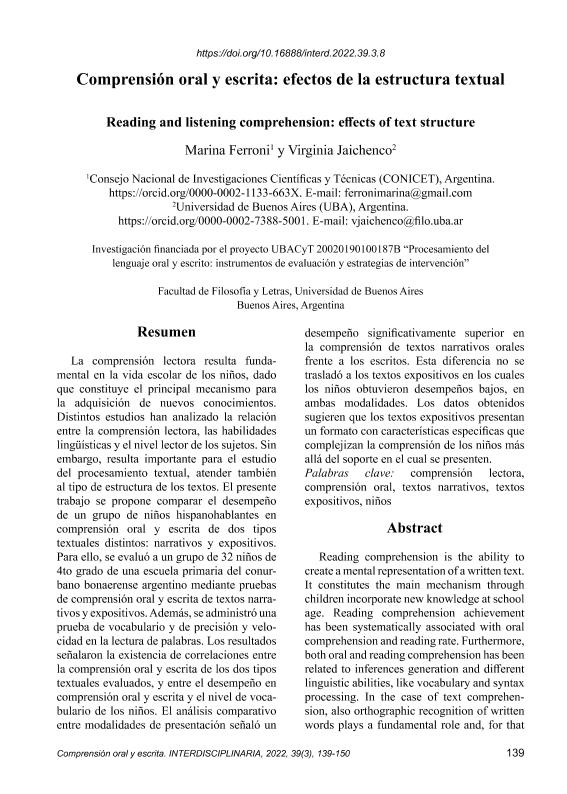Artículo
La comprensión lectora resulta fundamental en la vida escolar de los niños, dado que constituye el principal mecanismo para la adquisición de nuevos conocimientos. Distintos estudios han analizado la relación entre la comprensión lectora, las habilidades lingüísticas y el nivel lector de los sujetos. Sin embargo, resulta importante para el estudio del procesamiento textual, atender también al tipo de estructura de los textos. El presente trabajo se propone comparar el desempeño de un grupo de niños hispanohablantes en comprensión oral y escrita de dos tipos textuales distintos: narrativos y expositivos. Para ello, se evaluó a un grupo de 32 niños de 4to grado de una escuela primaria del conurbano bonaerense argentino mediante pruebas de comprensión oral y escrita de textos narrativos y expositivos. Además, se administró una prueba de vocabulario y de precisión y velocidad en la lectura de palabras. Los resultados señalaron la existencia de correlaciones entre la comprensión oral y escrita de los dos tipos textuales evaluados, y entre el desempeño en comprensión oral y escrita y el nivel de vocabulario de los niños. El análisis comparativo entre modalidades de presentación señaló un desempeño significativamente superior en la comprensión de textos narrativos orales frente a los escritos. Esta diferencia no se trasladó a los textos expositivos en los cuales los niños obtuvieron desempeños bajos, en ambas modalidades. Los datos obtenidos sugieren que los textos expositivos presentan un formato con características específicas que complejizan la comprensión de los niños. Reading comprehension is the ability to create a mental representation of a written text. It constitutes the main mechanism through children incorporate new knowledge at school age. Reading comprehension achievement has been systematically associated with oral comprehension and reading rate. Furthermore, both oral and reading comprehension has been related to inferences generation and different linguistic abilities, like vocabulary and syntax processing. In the case of text comprehension, also orthographic recognition of written words plays a fundamental role and, for that reason, reading comprehension would be a greater challenge than oral comprehension for early readers. Indeed, word recognition during reading is essential for text meaning construction. It is well known that a slow and laborious reading mechanism would overload cognitive processing and that reading automaticity is essential to carry out text processing. Longitudinal studies realized in different orthographies indicated that reading rate was the variable that had greatest impact on reading comprehension in early readers. In studies carried out in shallow orthographies, it was also observed that reading performance have an important impact on reading comprehension measure after 3 to 5 years of instruction. However, although impact of reading skills and oral comprehension mechanisms on reading comprehension has been reported in several studies, there is another important factor to consider: text structure. Studies propose that children tend to understand “narrative schemas” more easily since they are exposed to this type of text from a very early age. Likewise, all narrative texts present, in general, the same type of structure, respect temporal sequence of events and focus on story characters, their actions and motivations. In contrast, expository texts present new information to children, are oriented to a specific topic, contain less familiar and more technical vocabulary and a higher level of abstraction. This type of structure presents numerous cohesive connections and greater propositional density than narrative texts. The present study aims to compare listening and reading comprehension of narrative and expository text. For this, a group of 32 4th graders was evaluated in oral and reading comprehension of narrative and expository texts. In reading comprehension test, children read narrative and expository texts and then orally answered a series of questions. In oral comprehension, both narrative and expository texts were read aloud to children and then they answered questions about the texts orally. Vocabulary and reading rate were also measured. Data analysis shows correlations between oral comprehension and vocabulary. Reading comprehension were associated to vocabulary, oral comprehension and reading rate. Results suggest that oral and reading comprehension are associated with different linguistic skills and to each support access skills. In comprehension test, measures show higher performance in narrative oral comprehension texts when compared to reading comprehension. This result could be related to children reading rate. In fact, reading performance shows that children were “slow readers” according to the reading tests scales used in this study. Difference between oral and written comprehension in narrative texts, was not transferred to expository. In this type of texts children had low scores, without significant differences, in oral and reading comprehension. Results suggested that expository structures challenge children comprehension in both, oral and written modality. It is suggested that different types of expository texts difficult hierarchization of information that allows, in turn, the construction of text mental representation. Data of this study suggest the importance of establish interventions that allow children to improv text processing for access higher levels of comprehension in different textual structures. Furthermore, it is necessary in educational practices to expose children to expository structures from an early age. On the other hand, it is necessary to rethink reading instruction methods that originate low reading performance.
Comprensión oral y escrita: Efectos de la estructura textual
Título:
Reading and listening comprehension: Effects of text structure
Fecha de publicación:
09/2022
Editorial:
Centro Interamericano de Investigaciones Psicológicas y Ciencias Afines; Centro Interdisciplinario de Investigaciones en Psicología Matemática y Experimental
Revista:
Interdisciplinaria
e-ISSN:
1668-7027
Idioma:
Español
Tipo de recurso:
Artículo publicado
Clasificación temática:
Resumen
Palabras clave:
COMPRENSIÓN LECTORA
,
COMPRENSIÓN ORAL
,
TEXTOS NARRATIVOS
,
TEXTOS EXPOSITIVOS
Archivos asociados
Licencia
Identificadores
Colecciones
Articulos(SEDE CENTRAL)
Articulos de SEDE CENTRAL
Articulos de SEDE CENTRAL
Citación
Ferroni, Marina Valeria; Jaichenco, Virginia Irene; Comprensión oral y escrita: Efectos de la estructura textual; Centro Interamericano de Investigaciones Psicológicas y Ciencias Afines; Centro Interdisciplinario de Investigaciones en Psicología Matemática y Experimental; Interdisciplinaria; 39; 3; 9-2022; 139-150
Compartir
Altmétricas




